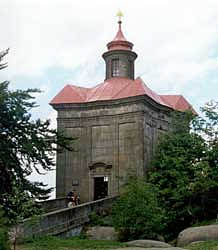
Desecrated churches serve various purposes, unused ones decay
 |
The church does not part with large churches, but the cases of small unused churches and chapels in communities where there are no believers will increase. The church would like to pass them on, intending that they continue to be used for spiritual or cultural purposes. However, private owners often do not want such properties because they do not intend to operate a non-profit activity.
In Catholic doctrine, a sacred space cannot be "deconsecrated." The loss of consecration can, according to theologians, occur primarily when the building has been largely demolished - when it is no longer defined by surrounding walls. Therefore, for churches that no longer hold services, the church expects that their use will be honorable. A case that caused outrage in the past was the Old Town Church of St. Michael, where an investor disturbed ancient graves and where a controversial show was held. On the contrary, the use of former churches in Prague, such as St. Roch's Church in Strahov, which houses the Miro Gallery, or St. Simon and Jude's, where concerts take place, are perceived positively.
The baroque church of St. Catherine in Pavlík was also transformed into a cultural venue. It was deconsecrated in 1950 and even faced demolition in the 1980s. The heritage, which has undergone several reconstructions, has been saved. It is now administered by the Gallery of the Capital City of Prague.
Activists from the Hnutí Duha Jeseníky plan to convert the church in Pelhřimov in the Bruntál area into a center for alternative culture and environmental education for youth. The dilapidated building without a roof was handed over to them by the leadership of the Ostrava-Opava Diocese. The church of St. Barbara in Štěpánov in the Olomouc region is also to become a cultural and social center in the coming years. The municipality has received the heritage from the church and intends to halt its long-term dilapidation.
In Boletice, in the Český Krumlov area, which is part of a military training area, efforts were made to save the church of St. Nicholas. The civic association of the same name eventually ended its activities because it was unable to lease the property from the army.
The municipal theater in Jablonec received the repaired Church of St. Anna, the oldest architectural monument in the city, from the city for administration. The dilapidated church was gifted to the town three years ago free of charge from the church, which lacked the funds for its renovation. The town took care of the reconstruction, and now the theater organizes exhibitions, classical music concerts, and intends to use it for theater and ballet as well.
Last year, the city in Chodov, in the Sokolov area, took over the church of St. Nicholas from the Catholic Church for free. Since the Plzeň Diocese lacked funds for renovation, the municipality secured them. Similarly, the Cheb municipality intends to proceed in this way after taking over the Franciscan monastery site from the church last year. The unused church is to serve for concerts or significant social events.
While in other regions, many churches have stopped serving their original purpose due to a lack of believers, in South Moravia, which is one of the most religious areas in the republic, the situation is opposite. Since 1989, prompted by believers, three dozen new Roman Catholic church buildings have been established in the Brno Diocese.
The only deconsecrated Catholic church in Vysočina is in Pelhřimov. The Church of St. Vitus previously belonged to the České Budějovice Diocese, and the town rented it from the church for 99 years about 15 years ago. It is used for organizing concerts and exhibitions and also serves as a ceremonial hall.
The vast majority of churches in East Bohemia still remain the property of the Catholic Church, even though it lacks funds for their repairs and maintenance. Exceptions, where churches serve only secular purposes, can be counted on one hand.
Problems with unused churches are also being addressed in Germany. Bishops approved a concept for the transformation of unused churches and criteria for decision-making about their future as early as 2003. Of about 24,000 Catholic sacred sites, it is now clear that 700 are changing or will soon change their purpose.
Conversely, in Austria, deconsecrating churches is very rare. Since the late 18th century, when many religious orders were dissolved by the decree of Emperor Joseph II, resulting in many monasteries and churches being closed, nothing similar has practically repeated. On the contrary, there is a noticeable return of certain deconsecrated objects back into church administration.
Similarly, in Slovakia, the church does not part with its churches, although their maintenance is costly. The vast majority of churches or temples are still being used for original purposes due to the large number of believers, and churches are still building new ones.
Predominantly Catholic Poland, where 93 percent of the population adheres to the faith in God, built new sacred sites in the 1970s to 1990s. Although their architecture varies, they share one common trait: they are still full of people.
The English translation is powered by AI tool. Switch to Czech to view the original text source.
0 comments
add comment
Related articles
0
08.03.2021 | The Church of St. Simon and Jude will be owned by FOK
0
22.12.2020 | Prague took over the deconsecrated Church of St. Simon and Jude in the Old Town
0
02.07.2020 | Prague will buy the church of St. Simon and Jude for 99.99 million crowns
0
15.06.2020 | Prague will buy the deconsecrated church of St. Simon and Jude for 99.99 million CZK
0
29.04.2020 | Prague has received approval from the Vatican to purchase the church of St. Simon and Jude
0
15.07.2019 | Prague has agreed to purchase the Church of St. Simon and Jude
0
05.09.2018 | Prague will buy the Church of St. Simon and Jude for 125 million crowns







